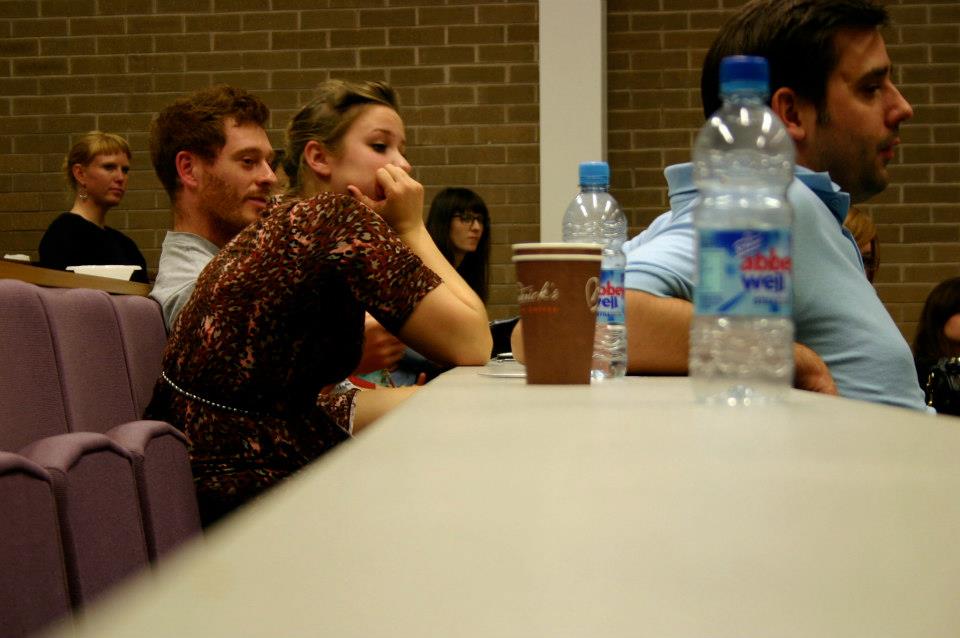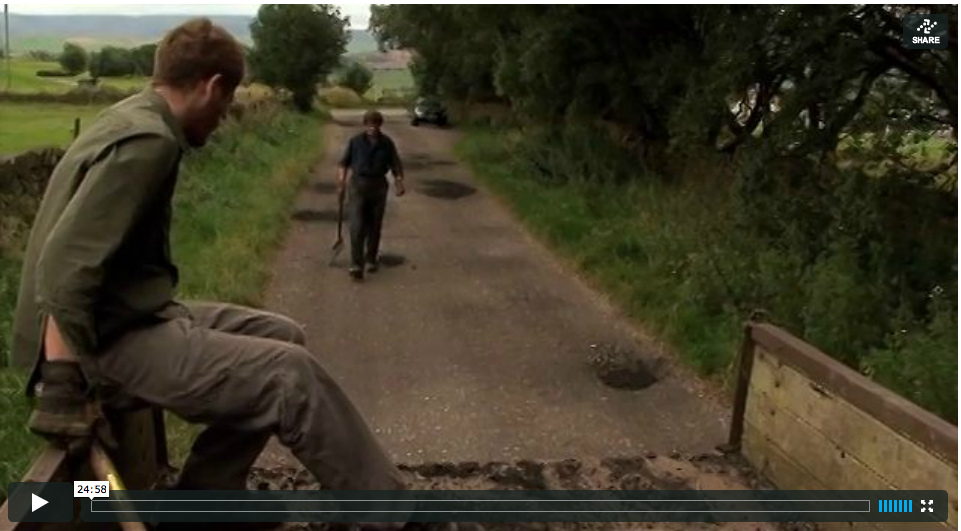“Two Blades of Grass”
November 1, 2012
Well, there you have it. The much-anticipated title of my film. Do you like it? It’s okay, I’m not sure about it either. Well, I thought I liked it at first, which is why it’s what I called my film, but now I’ve grown a bit detached from it and sometimes find it cringe-worthy. But maybe because it’s my film and I’m supposed to be critical.
So, I know this post is more than over-due, but it took a lot more out of me than I expected to fully settle back in to my home state and get into a routine again.

The theatre of the Bridgeford Humanities Building in Manchester
The film made its premier on Saturday, October 13th in Manchester. My main character Graham, and his girlfriend, Bethany, were in attendance, alongside the majority of my professors, coursemates, and their families. It was a pretty nerve-racking experience, seeing my film for the umpteenth time, but wondering what everyone around me was thinking, as it was their first.

Graham and Bethany listen to the panel discussion after the viewing
The Critics
Anthropologist Tony Simpson and filmmaker Gavin Searle sat on my panel, while one of my supervisors, Angela Torresan, moderated.

Defending my film alongside coursemates Jenni Smout and Jacob Harbord
One of Tony’s remarks was that he thought the scenes of Graham waking up and going to bed were repetitive and unnecessary. I questioned these, as well, for a bit, but decided to keep these shots as they paced the film and felt they reflected the countryside and ‘natural’ lifestyle.
Gavin called the film ‘experimental,’ referring to the opening and closing voiceovers, I assume. Which, if you didn’t read my last post, to clarify, were both written and recorded by Graham himself. For the themes of the interview questions I asked, I was inspired by the writings of anthropologist Tim Ingold on agricultural societies and perceptions of the environment. If you really want to read the particular text I’m referring to, click here.
And while Gavin found the relationship between George and Graham to be bitter and extremely unnatural, Tony felt that the relationship was quite touching and moving. He, along with many audience members, wanted to see that relationship further developed in the film. However, I didn’t want this strained relationship to be the film’s centerpiece, mostly out of respect for Graham and George. If Graham and George were both fully aware that I was creating a film about their particular uncomfortable relationship and their lives together on the farm, I think I would have no moral dilemma including those scenes or making that film; however, I did not feel it was ethical to portray that aspect in the film without making my intentions absolutely clear to my subjects. As an anthropologist, I will always respect them, their beliefs, and goals, before my own motives. As a filmmaker, however, I think it would have made for a very entertaining and compelling film indeed. But I cannot forget the strong anthropological background I have, which focuses on human study, which in turn, encompasses a plethora of ethical issues surrounding the treatment of human subjects.
As a person, it’s easy to judge others. As an anthropologist, it’s much easier. But also much more dangerous. In 1971, Alan Lomax published a set of rules or standards for future ethnographic filmmaking practices based on values of the American Anthropological Association and American society in the 1960s. Rule number one reads, “No one should be backed or encouraged to film in the field unless he is not only a competent but also an empathetic cameraman.” While our course has taught us competence, empathy is a to be skill learned and practiced. So it was empathy, then, that I strived for, ultimately this summer.
What would I change?
Well, there are some really simple technical issues I would change, such as some funky color, where color grading was rushed or botched, and some sound issues.
There are also some continuity errors that I recognize—no, I didn’t just miss them in the edit suite, I honestly tried to get around them, but there was just no solution, as the footage, ethnographically, was more valuable than the aesthetic. Most anthropologists will agree with this logic; many filmmakers, disagree.
As far as changing plot or sequences, these would be changes that would not be taken lightly. Given a longer editing period, I could have emerged with a few different versions of the film, had some time to play around with sequences, and develop certain areas further. But I had about six weeks to shoot, but only 13 days to edit. Large-scale documentary productions can have an entire team editing a project for months on end.
So, the film…
If you click on the image below, it will lead you to watch the film on Vimeo. But, before you click below, I add a disclaimer for those with arachnophobia. Please avoid 15:47—16:06.
I’d also like to add that there was a dedication prefacing the film, but it had to be removed for the web version due to festival submission guidelines. I would like to recognize here, though, that the film is dedicated in loving memory to my grandmother, Irene C. Shields.
Film basics
Running time: 25 minutes
Dir., Ed., Cam., Sound: Lara Stephenson
Music by: Eleanora
Location: High Peak, Derbyshire, England
Feedback
I’d love to hear from you. What did you like? What didn’t you like? Any interpretations you’d like to offer? Comments? Questions? I’ll field it all. Please feel free to comment here, on the Vimeo page, or send me an email.
What’s Next?
As some of you may know, I’ve just returned to the U.S. and am currently on the job hunt. It’s been disappointing to say the least so far, but I’ve still got optimism that something good will come my way. I’m looking for jobs in production; I’d prefer documentary production, specifically camera work, but I’d love to be involved in any aspect of production. So, if you have any job leads, cast them my way. If you’re an employer, please feel free to browse this blog or check out my Vimeo or LinkedIn profiles.
Leave a Reply Cancel reply
Grab Your Free Copy or Sign Up For The Newsletter
This is the blog post content. It's here to help show what a big block of text will look like. This text will all get replaced by actual blog content. It will be awesome. Vivamus suscipit tortor eget felis porttitor volutpat.
first name
email address
send me the goodies
On your wedding day all you have to do is focus on the love of your life. We're just there to document them. Bear claw marzipan cheesecake candy gingerbread cake.
Our Signature Services
Yay you're engaged! Looking to create save the dates, a wedding website or just show off your new bling?! Well it all starts with engagement pictures.
Are you a wedding photographer looking for dreamy presets? Well look no further you're in the right place!
wedding photography
engagement shoots
photography presets
view services
© 2024 Lara Rose | terms & conditions | Designed by Erika Maram | Photography by Lara rose
Follow along for editorial & documentary weddings


Be the first to comment